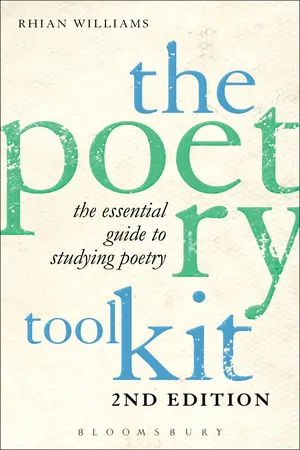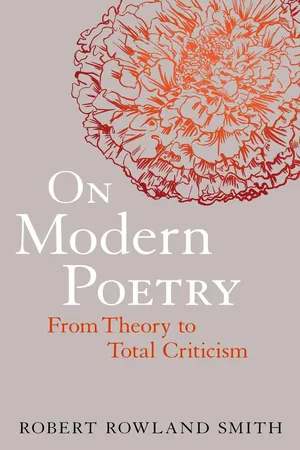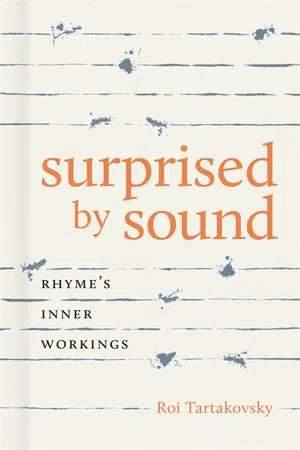Literature
Internal Rhyme
Internal rhyme is a poetic device where a word within a line of poetry rhymes with another word in the same line or within nearby lines. This technique adds musicality and rhythm to the poem, creating a sense of cohesion and unity within the verses. Internal rhyme can also draw attention to specific words or ideas, enhancing the overall impact of the poem.
Written by Perlego with AI-assistance
4 Key excerpts on "Internal Rhyme"
- eBook - PDF
- Rhian Williams(Author)
- 2013(Publication Date)
- Bloomsbury Academic(Publisher)
Internal Rhymes might predict end-rhymes, as in Blake’s ‘The Garden of Love’: And Priests in black gowns were walking their rounds , And binding with briars my joys and desires . William Blake, ‘The Garden of Love’ (1794), ll. 11–12. Or they may remain entirely internal, as in Hopkins’s ‘God’s Grandeur’: Generations have trod, have trod, have trod; And all is seared with trade; bleared , smeared with toil; Gerard Manley Hopkins, ‘God’s Grandeur’ (1918 [c. 1877]), ll. 5–6. Internal Rhymes might even reach across lines, skipping over the line endings altogether, as in Rossetti’s Goblin Market . The cat-faced purr’d, The rat-paced spoke a word Of welcome, Christina Rossetti, Goblin Market (1862), ll. 109–11. Internal Rhyme treads a careful line between artificiality (as the sounds are contrived to chime) and naturalness (the position of the rhymes occurs naturally rather than in fixed positions). However, as we will see below, Internal Rhymes are actually more likely to be imperfect rhymes . Perfect rhymes in quick succession can create an overloading effect; the gradual building up of imperfect chimes, on the other hand, can create a more subtle effect of accumulation. Indeed, imperfect rhymes that slip beneath our radar seem suited to an internal position: their obliqueness finds them hiding within lines rather declaring themselves more obviously at line ends. Internal Rhyme in combination with Internal Rhyme The repetition of sounds within a line of verse. Rhyme 171 imperfect rhyme can be subversive: it is a gesture at harmony and a rejection of its obviousness. 4.2 Imperfect rhymes Imperfect rhyme (or slant rhyme ) Constructions where the rhymes are only partial or slight correspondences of sound because only the vowel or the consonant sounds are repeated. - eBook - PDF
On Modern Poetry
From Theory to Total Criticism
- Robert Rowland Smith(Author)
- 2012(Publication Date)
- Continuum(Publisher)
A rhyme requires the back end of the two words to be the same, but the front end to vary. Though Internal Rhymes can and do exist, this whole-word rule is what generally dissuades us from breaking poems down to smaller units whereby letters in individual words could rhyme with the same letter in any other word. Conversely, rhyme should not operate with units larger than the word, because a rhyming phrase, in which all the words in a sequence match all the words in a previous sequence in order, would be something else altogether. Here is another I have made up: Days come. Days go. Plays dumb. Says no. RHYME AND REASON 29 Again, one can dress the lines up with semantic trappings, and so make them mean something. After all, the complete repetition in line 2 of the sounds from line 1 seems to reinforce the poem’s ‘theme’ of a circular pointlessness. But we would still say the rhyme as such belongs with ‘go’ and ‘no’. And if the rhyme belongs with the end-words, it means rhyme cannot be separated from rhythm. There is ‘nosing’ in line 3 and ‘roaring’ in line 6 of the Lowell above; ‘break’ in line 1 and ‘weak’ in the ‘weak-fleshed’ in line 5; and so on. All are whole words in their own right, and all ‘rhyme’ in a certain sense. But what prevents them from rhyming properly is where they have been placed. The gratifi-cation that comes with rhyme has to do with more than semantic connection; the fact the gratification is both expected and deferred gives a rhyme its special quality, and to such an extent that grati-fication and semantics, meaning and pleasure, cannot be so easily divorced. - eBook - ePub
Surprised by Sound
Rhyme's Inner Workings
- Roi Tartakovsky(Author)
- 2021(Publication Date)
- LSU Press(Publisher)
26 We can observe a similar maneuver if we add the last line of the previous stanza:Herself - though - fled !Another bed - a short one -Due to the rhyme, there is a likely pause after bed; the word is perceived as a sonic end, a closing of rhyme that started with fled. This sense of an ending is aided by the phrasal and rhetorical break that is represented by the subsequent dash, a hallmark of Dickinson’s poetics. And yet there is an alternative end close at hand, that of the line unit, with which this end does not coincide. The ending of rhyme is counterbalanced by the continuation of the line.In this way, rhyme is akin to punctuation, sonically punctuating the line. Internal Rhyme has a rhythmic effect on the pacing of the line: rhyme is a cue for accenting and pausing. If the second of the two rhyming partners cues for pause, it does so in this poem by joining the numerous dashes, line ends, and phrasal ends. The entire stanza becomes acutely disjointed at each step, and the poem rarely lets us go more than two or three words before forcing some kind of halt. The overall effect, quite typical of Dickinson, is that fraught admixture of high bursts of energy amid much hesitation.SPORADIC RHYME, ENDINGS, AND CLOSURES
Finally, I would like to turn to the employment of sporadic rhyme in the most strategic of places in a poem: its ending. When rhyme comes at the poem’s end, at least two endings overlap: the end of the rhyme—reached with the second of the two rhyming words—and the end of the poem. Barbara Herrnstein Smith has shown that poems tend toward “terminal modification,” a change that comes at the end of the poem to strengthen closure and break the expectation for the continuation of the same. In a consistently rhyming poem, terminal modification can be achieved with a change in the rhyme scheme. A prime example is the Shakespearean sonnet: after three quatrains in a row, one is set up to expect more quatrains, but then the poem signals its ending by switching to a couplet. The concluding couplet, Smith writes, is a terminal modification that has become “incorporated into the convention of the sonnet” (53). And the same concluding couplet can just as easily signal an ending in other contexts. A nonrhyming speech in a play, for instance, could end ceremoniously with a rhyme that would reinforce the fact that it is an ending.27 - eBook - PDF
Studies in the History of the English Language
A Millennial Perspective
- Donka Minkova, Robert Stockwell, Donka Minkova, Robert Stockwell(Authors)
- 2008(Publication Date)
- De Gruyter Mouton(Publisher)
Finally in section 4 I briefly note some ways in which the vowel differences found in Pope’s rhymes in “The Rape of the Lock” diverge from those in Shakespeare, in order to show that the historical issues raised by variation in rhyme are not only synchronic ones about literary language of the past, but also true diachronic ones of how poetic forms are transmitted within a tradition. 2. The rhetoric of partial rhymes 2.1 Defining “partial rhyme” The array of conflicting terminology used in relation to rhyme necessitates a comment on how terms are used here. Loosely speaking, rhyme involves the occurrence for poetic purposes of the same sounds at the ends of dis-crete stretches of language. Describing it more formally involves specify- 210 Kristin Hanson ing where those stretches of language are located in a text, which parts of them are repeated, and how complete the repetition is. In English, the ca-nonical form of rhyme as a structural device in poetry – indeed its defini-tion for many – involves the syllables in the final strong metrical position of discrete lines, and requires the nuclei of those syllables and all segments following to the end of the line to be identical. The issue of location, inter-esting though it is across the tradition, will not be of concern here; all the rhymes considered are end-rhymes in the canonical location, as in (1) and (2). What is trickier is the interrelationship of the other two issues, for the fundamental subject here is whether and if so how the nuclei of those syl-lables may be implicated in some relationship of repetition, and yet not be identical. The necessary distinction is carefully expressed by Rickert (1978), who reserves the term “rhyme” for the form in which requirements of repetition are imposed on the nuclei of rhyming syllables as well as what follows, as opposed to “slant rhyme”, in which requirements of repetition are imposed on the final consonant only.
Index pages curate the most relevant extracts from our library of academic textbooks. They’ve been created using an in-house natural language model (NLM), each adding context and meaning to key research topics.



